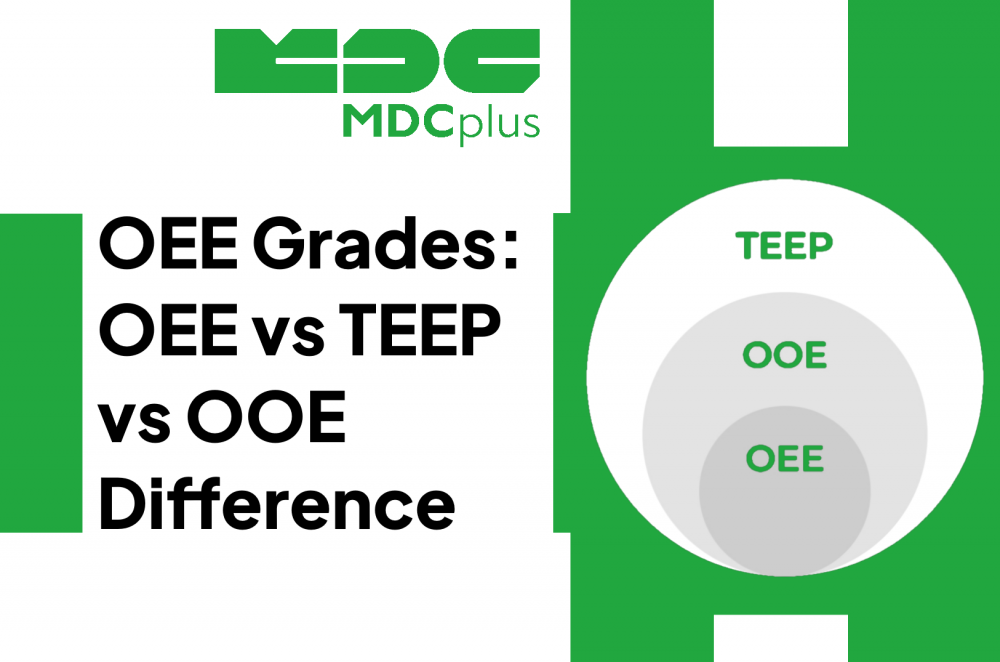When backlog grows, two questions matter: are we running poorly during scheduled time, or are we simply not running enough hours? Put them on one page and the right lever becomes obvious.
Plain-English definitions
- OEE – Effectiveness during the time you planned to run. Formula: Availability × Performance × Quality. Nights you did not schedule do not count.
- TEEP – Effectiveness against the full calendar. Formula: Utilization × OEE, where Utilization = Planned Production Time ÷ Calendar Time.
- OOE – Effectiveness against all time you realistically could have run if demand and staffing allowed. Formula: Loading Utilization × OEE, where Loading Utilization = Loading Time ÷ Calendar Time and Loading Time excludes only true no-demand.
Rule of thumb for the same asset: OEE ≥ OOE ≥ TEEP.
The denominator is the story
Think in three weekly buckets per machine:
- Calendar time – 168 h
- Loading time – calendar minus true no-demand windows
- Planned production time – shifts you actually scheduled
Change the denominator and the message changes with it.
Walk-through example
A plant runs 2 shifts × 6 days → Planned 96 h. Calendar is 168 h. During the 96 h, the line runs at:
- Availability 85 %
- Performance 95 %
- Quality 98 %
Compute OEE
0.85 × 0.95 = 0.8075
0.8075 × 0.98 = 0.79135 → 79.1 %
Compute TEEP
Utilization = 96 ÷ 168 = 0.571428… → 57.1 %
TEEP = 0.571428… × 0.79135 ≈ 45.2 %
Compute OOE
Loading time = 6 days × 3 shifts = 144 h
Loading Utilization = 144 ÷ 168 = 85.7 %
OOE = 0.857142… × 0.79135 ≈ 67.8 %
Same line, three truths: OEE 79.1 %, OOE 67.8 %, TEEP 45.2 %.
If the ideal cycle is 60 s, 96 h hold 5,760 ideal parts. At 79.1 % OEE, that is about 4,558 good parts. TEEP shows why orders still slip – only 57 % of the week was scheduled.
When to use which metric
-
Use OEE when the focus is how well the line runs during scheduled hours – kill micro-stops, speed losses, and scrap.
-
Use OOE when machines sit idle despite available demand or staffing – exposes starvation, material flow, or labor gaps inside the workweek.
-
Use TEEP when demand outstrips what the current schedule can deliver – quantify the upside of adding shifts, weekends, or lights-out windows.
Decision cheat sheet
-
Backlog rising and OEE already ≥ 75 % – start with TEEP. Add hours or shifts.
-
Plenty of orders but machines idle mid-shift – track OOE. Fix release timing, staffing, or internal logistics.
-
Orders stable, costs high – drive OEE with classic Lean work on changeovers, micro-stops, and first-pass yield.
Minimal data to collect
No extra hardware on CNCs. With MDCplus a networked CNC connects over Ethernet and streams directly to the server.
- Planned time – shift calendar
- Run time – spindle or program active
- Ideal cycle time – per part from the NC program
- Actual cycle time – completion timestamps
- Total vs good parts – piece counter plus reject ticks
- No-demand windows – planner marks true periods where the asset would not run even if it could
For manual environments, a one-page tally per shift works: start time, stop time, stop reason code, total pieces, scrap pieces. Keep it simple and consistent.
Dashboards that keep it honest
A straightforward layout per line in MDCplus:
- Row 1 – OEE for the current shift and week to date
- Row 2 – OOE with a label that reads excludes no-demand only
- Row 3 – TEEP plus an inline Utilization value
Add weekly sparklines for all three and an overlay of planned vs loading time. Everyone sees when the denominator moves.
Typical traps and quick fixes
- No-demand vs no-plan confusion – if the team chose not to schedule but would run if asked, count it in Loading time for OOE, not as no-demand.
- Fishing for bigger numbers – OEE is usually the highest. Pair it with OOE and TEEP on the same tile so capacity conversations stay grounded.
- Invisible micro-stops – OEE looks fine while Performance quietly bleeds. Track short stops under 5 minutes and treat them as first-class losses.
- Shifting schedules without impact – if you add a weekend shift and TEEP does not jump, the constraint is staffing or material release.
Two quick cases
-
Backlog on a discrete CNC line
OEE 78 %, TEEP 41 %. Adding a Sunday 12 h window lifts TEEP to 48 % the next week. Programs unchanged. Orders shipped. -
Flow-starved assembly cell
OEE 74 %, OOE 55 %, TEEP 55 %. Advancing kit release by one hour and rebalancing lunch coverage pushes OOE to 63 %. Output rises with zero extra hours.
Pick the metric that matches the real constraint. Use OEE to improve runtime quality, OOE to expose idle pockets inside the week, and TEEP to size the gap to full-calendar capacity. With MDCplus connected directly to your CNC controls, the numbers arrive without pens, clipboards, or edge devices – just data that tells you exactly which lever to pull next
